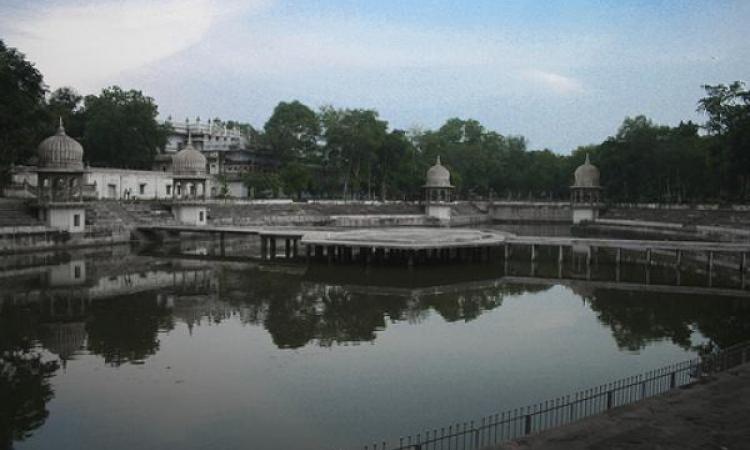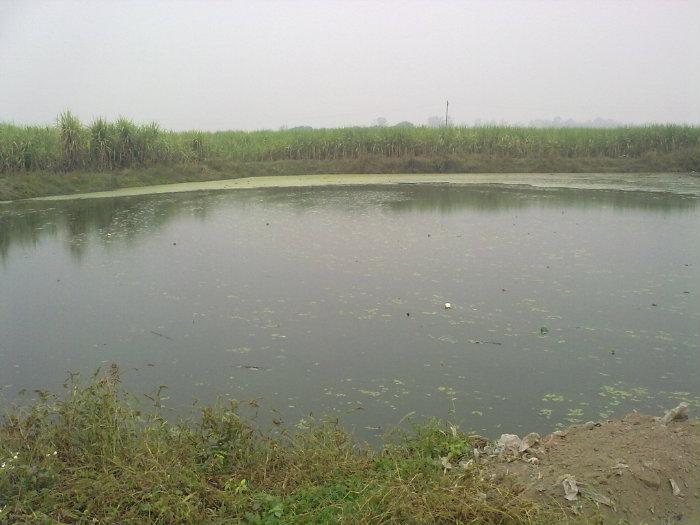
Traditional water bodies such as bawdis and talabs have long since been an integral part of rural life in India providing water, fish and sometimes even just a venue for people to chit chat. The flat plains in Western Uttar Pradesh, where the Ganga and Yamuna rivers meet, is no exception. Once home to many such water bodies, this area where the epic Mahabharata was set, has slowly given way to rapid urbanization.
Gandhari talaab mythically used by Gandhari the mother of the Kauravas, and Suraj kund a reservoir that can be traced back to the times of Baba Manohar Nath, a contemporary of the famous Sufi saint Shahpeer, were once situated here. The Baba Manohar Nath temple was built during Mughal Emperor Shah Jahan's time alonside a mausoleum. The water from the kund was used for religious purposes, ritual baths as well as for water harvesting.
The Meerut Gazetteer records how Lala Jawahar Mal, a local ruler impressed with its healing powers renovated the water body in 1700. During the Mughal period the pond was filled with the water of Abu Nala and later, with the waters of the Ganga canal. The next to take over the upkeep of these water bodies were the British. It was when they handed over this responsibility to the Municipality in 1865, did the neglect begin.
View Parikshitgarh in a larger map
Revenue records suggest that there are 3062 water bodies in 663 villages in Meerut district alone. Till the 1960s, these water bodies were visible all around the city and formed an important water buffer, especially during the summers. Most of them are in a pitiable state now and have been encroached upon by people right under the nose of the administration. Gandhari talaab, 60 m long, 50 m wide and 6 m deep, is no longer suitable to recharge groundwater. This water body located in Parikshitgarh block in Meerut district dried up three decades ago and has now been encroached upon.
A possible reason why this happened and continues to happen is the lack of ownership and lack of sense of belonging within a community post-colonialism. Earlier, there were self-organized systems of conserving water bodies by the communities that used them. Colonial intrusion disturbed this community form of management and gave preference to private as well as state property rights. This method of governance continued post-independence as well. Today, people have lost the emotional connect they once shared with these water bodies and seldom use them. Due to this neglect, most of these water bodies are choked up with sewage waste, plastic and other garbage.

The stories of about 60 such water bodies in Western Uttar Pradesh, many dating back to medieval and colonial times, have been compiled into a booklet titled “Pashchimi Uttar Pradesh ke Jalashay: Ek aitihasik viraasat” by Harishankar Sharma. The booklet also documents the location, associated mythology and the current status of these tanks. It lists the ones that are now looked after by the Archeological Survey of India as they were home to ancient texts, inscriptions, local lore and archaeological remains.
Land hunger has led to the demise of these water bodies
Most people in the area attribute the deteriorating condition of these ponds to the illegal constructions encroaching into the water body. This coupled with the illegal groundwater extraction by sugar industries in the area has worsened the condition of these water bodies. In addition, the state and the land mafia actively collude to bring about a change in the way the land is used. They use the dried-up water body as a garbage dump and then reclaim it later and then put it up for sale.
Neer Foundation, a Meerut-based NGO, recently conducted a data-based collative study on the natural water bodies and other water sources of the area including Gandhari talaab, Navaldeh kuan, Shragrishi Ashram ki Jheel and others. Results indicated that only 170 of the original 260 ponds are still present in the 52 villages in the Parikshitgarh block in Meerut district. The 125 that have gone missing are either being used for agriculture or have been built upon. The area is now faced with severe water crisis.
Save our water bodies, save ourselves
It is only over the last few years that people have begun to realize the strain caused by the poor management of water bodies, which also results in a water shortage. Civil society groups in Meerut have highlighted the need to revive the water bodies that punctuate the region. NGOs have approached the court through a Public Interest Litigation to restore these water bodies in addition to undertaking initiatives to revive them using local shramdaan (voluntary labour).
While it is important to revive ancient water harvesting systems to store natural water and distribute it equitably, it is equally important to return to a community-based water management system. Unless people feel the responsiblity and ownership towards these water bodies, the emotional connect that once existed will be hard to revive, as will the water bodies that continue to die today.